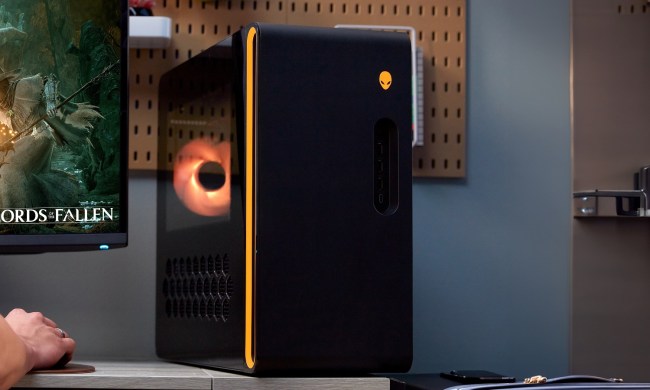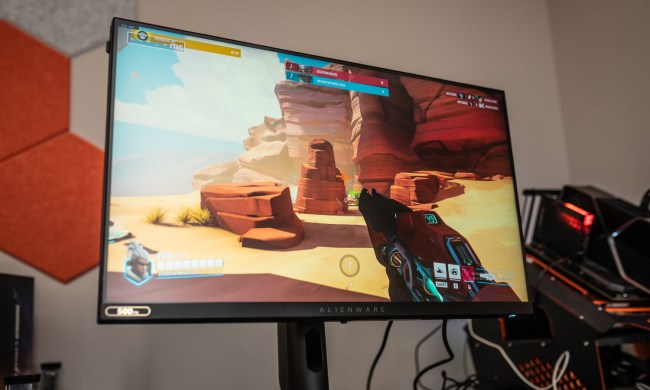“Alienware isn't blowing hot air when it claims that the M17x is the most powerful 17-inch laptop in the universe.”
- Ridiculously powerful
- thanks to processor
- graphics
- and memory technology; appealing design
- albeit a little geeky; plenty of perks
- including AlienSense facial recognition and the ability to switch between integrated and discrete graphics
- Slurps up power like a storm grate swallowing water; at $5
- 600 fully loaded
- it costs as much as a good used car
Alienware has been advertising its latest portable gaming rig as the “most powerful 17-inch laptop in the universe.” We’re not sure how to go about verifying the off-planet portion of that claim, but as far as Earthly laptops go, it’s hard to dispute. A fully tricked-out model like the one we had the opportunity to test comes equipped with Intel’s fastest mobile processor, a pair of NVIDIA’s quickest mobile graphics cards, and 8GB of the speediest memory around. It’s easily the best performing notebook we’ve ever tested. And, at over $5,000 fully loaded, it’s also one of the most expensive.
Design
Like many other high-end hardware makers, Alienware has hopped on the anodized aluminum chassis bandwagon, and it’s for the better. The M17x’s brushed metallic exoskeleton—available in red, silver, or black—is pretty, pleasantly cool to the touch, and hardly shows a trace of accidental bumps and scrapes. It’s also lightweight, which is good since the laptop already tips the scales at nearly 13 pounds—not including its giant battery, which itself is nearly as weighty as a netbook. Any heavier and we’d start to seriously question its designation as a portable PC.

Like most Alienware notebooks, the M17x is equipped with the company’s patented Alien-FX lighting. The keyboard, mouse pad, accents around the edge of the machine and Alienhead logo glow with light that can be customized via a simple preinstalled application.
The finishing touch: A slot-loading optical disc drive (a Blu-ray burner, in the case of our evaluation unit) on the right, which adds a bit of elegance to a design which, while undeniably pretty to a gamer’s eye, might seem a bit ostentatious to mainstream consumers.
Performance
While thoughtful design is appreciated, the primary reason people buy Alienware rigs is for their unparalleled performance, and, happily, that’s where the M17x shines brightest.

The first thing we did upon booting the M17x up was install and run 3DMark Vantage’s 3D graphics benchmarking software. It achieved an overall score of P12084 3D marks—the best of any portable PC we’ve ever tested. To give that number some context, it’s triple that of ASUS’ G51Vx—which is a fair bit less expensive, but still no gaming slouch—and more than double that of HP’s Firebird, a desktop rig with VoodooPC DNA.
We also ran the benchmark built into Massive Entertainment’s World in Conflict, which resulted in similarly impressive results. The M17x is the first laptop we’ve seen ace this test, averaging nearly 50 frames per second with all visual settings set to “very high” and at a maximum resolution of 1920-by-1200. (We achieved a buttery-smooth 70 frames per second when be bumped the resolution down to 1440-by-900).

Our unit shipped with a terabyte of 7200 RPM hard disk storage formatted in RAID 0 (RAID 1 is available as well), but if you want to significantly boost gaming load times you can opt for 512 MB of solid state storage—assuming you’re okay with adding $650 to the machine’s already hefty price.
Battery Life
Of course, all of this horsepower comes at a cost to battery life. Alienware has once again included the ability to switch from the machine’s energy hungry discrete graphics to the integrated motherboard GPU (which happens to be an impressive little GeForce 9400M), but don’t expect miracles.
We weren’t able to get through even a short feature-length film on battery power alone. We got about 80 minutes with the optical drive engaged, speakers cranked, and screen brightness set to maximum.

Ins and outs
As you’d expect from a big rig, the M17x is loaded with connectivity options, including Bluetooth, Wireless-N, and Ethernet.
It’s also got a full complement of audio and video ports. Users can hook up the laptop to just about any display they like, thanks to VGA, HDMI, and DisplayPort connectors. A rear speaker jack on the right side of the machine makes setting up a surround sound environment a snap, while a pair of headphone ports means more than one person can enjoy movies when silence is required in the immediate vicinity. You can hook up an external mic if necessary, though we found the collection of digital array mics above the screen did a lovely job recording spoken word.

Basically, you can connect anything and everything you like to the M17x.
Also worth a quick note is a security feature enabled via the laptop’s webcam called AlienSense. Every time you log on to Windows the camera maps your mug. After a few sessions, AlienSense will begin to recognize your face and log you in automatically. No need to type a password. It beats the heck out of temperamental fingerprint readers and will be especially handy in situations in which the machine is frequently accessed by different users.
Conclusion
If we had our druthers, this would be the notebook residing on our desk. It can handle any graphics intensive app and eat up any game you throw at it. Indeed, this is the first notebook we’ve tested that truly made us think monster desktops might really be an endangered species.
Of course, you’ll need to be able to swallow the M17x’s price, which sits around $5,600 if you tick off the checkboxes beside all of the hardware mentioned in this review (including the solid state storage option).
You could choose less powerful components and lower the price all the way down to $1,799, but then you’d have a notebook which, from the perspective of performance, isn’t much different than machines currently available from plenty of other manufacturers. The point of the M17x is that it outclasses all other laptops (and the vast majority of desktops). Start pulling out power components and you lose the machine’s raisons d’être. We don’t recommend it. The M17x really is an all or nothing proposition.
If you plan to place an order, we’ve little doubt you’ll be satisfied. You’d just best hope your family didn’t have their hearts set on next summer’s Caribbean cruise.
Pros:
- Ridiculously powerful, thanks to bleeding edge processor, graphics, and memory technology
- Appealing design, albeit in a geeky sort of way
- Plenty of perks, like AlienSense facial recognition and the ability to switch between integrated and discrete graphics
Cons:
- Slurps up power like a storm grate swallowing water
- At $5,600 fully loaded, it costs as much as a decent used car




